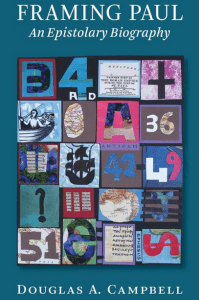 Douglas Campbell has become a major player in the world of Pauline studies with his last two books in this sense: he has not only proven his competence in exegesis, theology and history but has proposed a re-centering of Pauline theology around the theme of apocalyptic. (Some have said Barth’s had his share of influence, too, but that influence has been mediated as much through Torrance.) His first foray into this approach was called The Quest for Paul’s Gospel: A Suggested Strategy, while his second was a mammoth volume: The Deliverance of God: An Apocalyptic Rereading of Justification in Paul.
Douglas Campbell has become a major player in the world of Pauline studies with his last two books in this sense: he has not only proven his competence in exegesis, theology and history but has proposed a re-centering of Pauline theology around the theme of apocalyptic. (Some have said Barth’s had his share of influence, too, but that influence has been mediated as much through Torrance.) His first foray into this approach was called The Quest for Paul’s Gospel: A Suggested Strategy, while his second was a mammoth volume: The Deliverance of God: An Apocalyptic Rereading of Justification in Paul.
Campbell is intent to prove there are three soteriologies in Paul’s letter to the Romans: justification by faith (Rom 1-4), the apocalyptic “in Christ” gospel (Rom 5-8) and salvation history (Rom 9-11). He contends Rom 5-8 is the apocalyptic gospel and needs to be elevated above the others — by elimination and by subordination. He contends the apocalyptic gospel alone sustains the Pauline gospel throughout his correspondence. More of this at a later date.
Penetrating the whole of his project is a chronological ordering of the Pauline letters in a biography based on the evidence in the Pauline letters (read: genuine Pauline letters, and he’s not a skeptic on this one). The title is: Framing Paul: An Epistolary Biography. Notice the method: if the standard method is to conflate Acts with Paul’s letters, leading Campbell to say Acts has the upper hand far too often, his approach — which revives the work of John Knox and then takes it to a new level — is to base everything on the Pauline evidence for Paul was a firsthand witness!
Every competent discussion of Pauline chronology and biography entails intense discussion of passages and cannot be reduced to simple summaries, but Campbell does us all a great service by outlining his conclusions at the end and I will now post them with this warning: each line (and other lines not here mentioned) requires intense and careful study, and he’s done that.
The Basic Sequence of Paul’s Letters
// ca. 40 ce //
1 Thess — 2 Thess
// 43-49″- years of shadow //
//50//
Laod (“Eph”) / Col / Phlm … [PLC] [=previous letter to Corinth]
//51//
1 Cor — 2 Cor — Gal/[PLP]((Phil 3:2–4:3)) — Phil
//52//
( – Phil?) – Rom …
Now in more detail…
The Detailed Sequence of Events Surrounding Paul’s Letters
Prior to 34 ce: Previous life as a Pharisee
Persecution of the early church in Jerusalem
Early/mid-34: Apostolic commission near Damascus
Early 34-mid-36: Activity in the region of Damascus
Activity in “Arabia”
Return to Damascus
Late 36: Escape from Damascus, from a governor appointed by King Aretas IV
Pauls first visit to Jerusalem, 2.x years after commission
Activity in Syria and Cilicia presumably begins
37-38: Probable activity in Syria and Cilicia, including in Antioch
(Late 39/early 40): Announcement of Gaian plan to desecrate the Jerusalem temple
Ca. 40-42: Mission to Macedonia:
Founding visit to Philippi
Founding visit to Thessalonica
Mission to Achaia:
Founding visit to Athens
Timothy s visit from Athens to Thessalonica and back
1 Thessalonians
Arrival of further news from Thessalonica
2 Thessalonians
Founding visit to Corinth
Ca. 43-49: Years of shadow: extensive travel
Mission to Illyricum
Mission to Galatia (the most plausible location currently)
Possible missions to Moesia, Thrace, Bithynia, Pontus, and Cappadocia
Sufferings from travel (shipwrecks) and disciplinary measures (whippings and beatings with rods)
Paul’s second visit to Corinth (during or adjacent to this period)
Late 49/early 50: Antioch incident (Gal 2:11-14)
Paul’s second visit to Jerusalem, 13.x years after first visit; collection inaugurated
Mid-50: Return to the Aegean by way of Antioch and Galatia
Mission to Asia:
Imprisonment en route, possibly in Apamea
Founding of congregation at Colossae by proxy
Laodiceans (“Ephesians”) / Colossians / Philemon
Release from prison; visits to Lycus valley communities
Founding visit to Ephesus
Late 50: [Previous Letter to Corinth]
Apollos s first visit to Corinth
Winter 50-51: [Corinthian reply]
Informal oral reports from Corinth
Spring 51: 1 Corinthians, later defined as Letter of Tears (2 Cor 2:4), probably dispatched with Timothy
Apollos s second visit to Corinth
Super-apostles’ visit to Corinth (if they are different from the foregoing)
Titus’s first visit to Corinth, with instructions to rendezvous with Paul in Macedonia or northern Asia
Asian crisis, probably in Ephesus (2 Cor 1:8-10)
Paul’s departure from Ephesus for Troas and then Macedonia
Ca. summer 51: Rendezvous with Titus in Macedonia
2 Corinthians
Titus’s second visit to Corinth, bearing 2 Corinthians
Paul’s third visit to Corinth
Fall 51-winter 51-52: Enemies’ arrival in Corinth (see Phil 3:18)
[Previous Letter to Philippi] (Phil 3:2-4:3)
Galatians
Paul’s imprisonment and capital trial
Epaphroditus’s visit from Philippi and ensuing illness
Philippians, dispatched with Epaphroditus
Timothy’s visit to Philippi
Paul’s release from prison
Spring 52: Romans
Paul’s departure with the collection for his third visit to Jerusalem, via Macedonia, and presumably also Asia — ultimately bound for Rome
The authentic epistolary sources lose sight of Paul at this point. (A pseudonymous epistolary source — 2 Timothy — suggests that he was executed in due course at Rome.)











